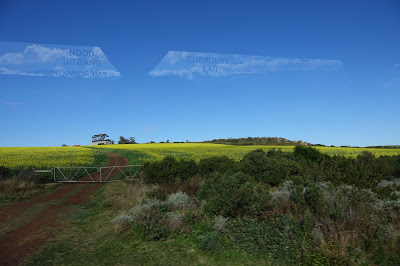We stopped in Hermanus for several hours - long enough to enjoy the ocean views, walk around town, and have a bite to eat. It is known for whale watching. Whales arrive sometime in June and stay until early December. I didn't catch sight of any but I was still taken with the beauty of the place.
We departed late afternoon and arrived in Cape Town in time to check in to the hotel (the Inn on the Square) and head out to the waterfront for dinner. The next morning we returned to the Victoria and Alfred Waterfront to take a ferry to Robben Island (Dutch for seal island), where Nelson Mandela, among many others, was imprisoned for over twenty years. The island has an interesting history dating back to the 17th century. It was a leper colony (and destination for other "undesirables") and held many political prisoners throughout. Apartheid ended in 1994 and the medium-security prison closed in 1996. It then became a tourist attraction, with visitors from around the world. It was named a World Heritage Site in 1999.
Clock Tower at the Victoria and Alfred Waterfront
Approaching Robben Island by ferry; lighthouse in the distance.
The pier at Robben Island
Cemetery for lepers who lived on the island
The lighthouse on Robben Island, completed in 1865. Prior to its completion,
bonfires were lit on the highest part of the island to warn ships.
A view of Cape Town and Table Mountain from Robben Island
The windswept island was always home to seals and penguins.
Other animals were introduced beginning in 1654, when Dutch settlers released rabbits as
Other animals were introduced beginning in 1654, when Dutch settlers released rabbits as
a source of food for passing ships. The African penguins were completely exterminated by
1800 but today there is again a thriving colony. In 1958, other animals were introduced, including
tortoise, duck, geese, buck, Ostrich and a few Wildebeest, which did not last long. Today the
1800 but today there is again a thriving colony. In 1958, other animals were introduced, including
tortoise, duck, geese, buck, Ostrich and a few Wildebeest, which did not last long. Today the
island is overrun with rabbits and hunting is permitted in order to reduce their numbers.
Our guide describes his life as a political prisoner on Robben Island.
A small garden in the corner of the prison yard where pages from the manuscript of
Mandela's Long Walk to Freedom were buried in tin cans to hide it from the guards.
This article from BBC News tells the story.
Mandela's Long Walk to Freedom were buried in tin cans to hide it from the guards.
This article from BBC News tells the story.
Nelson Mandela's Cell














